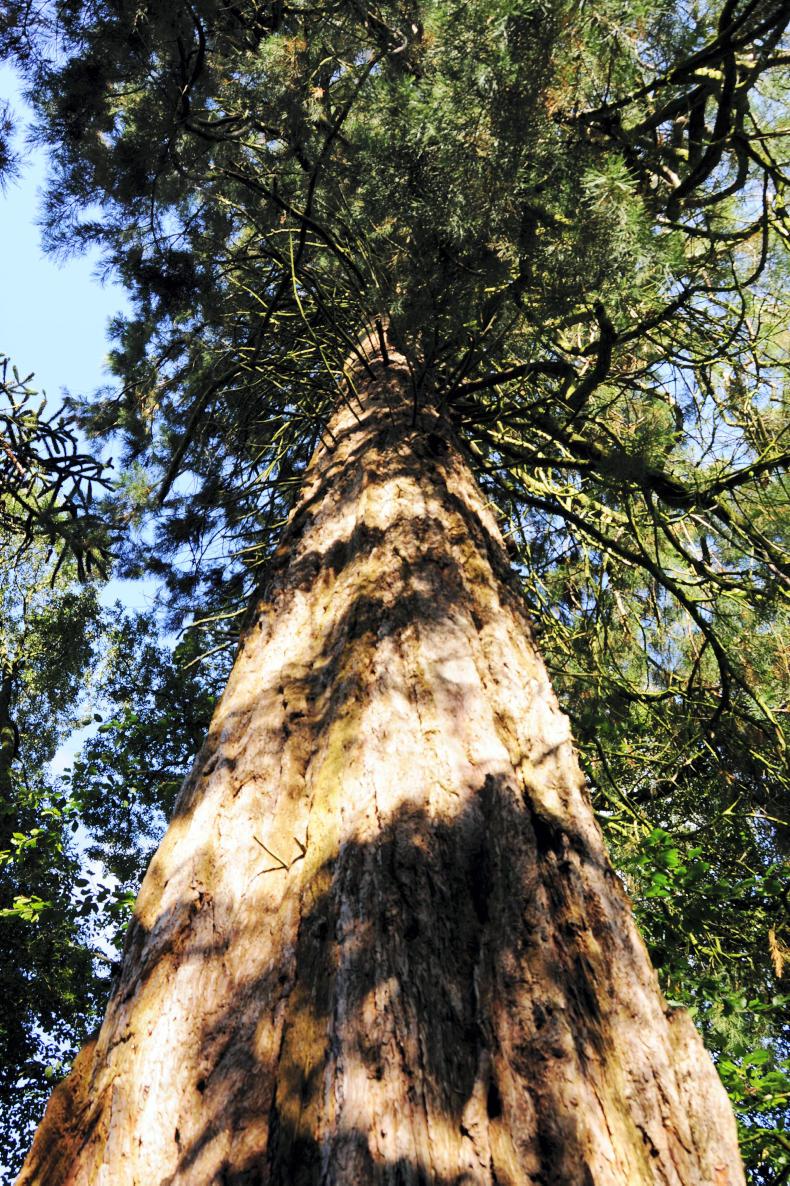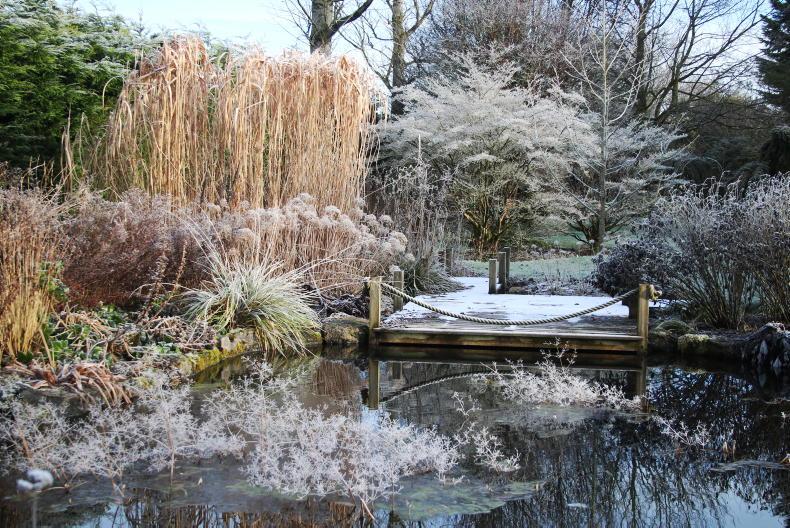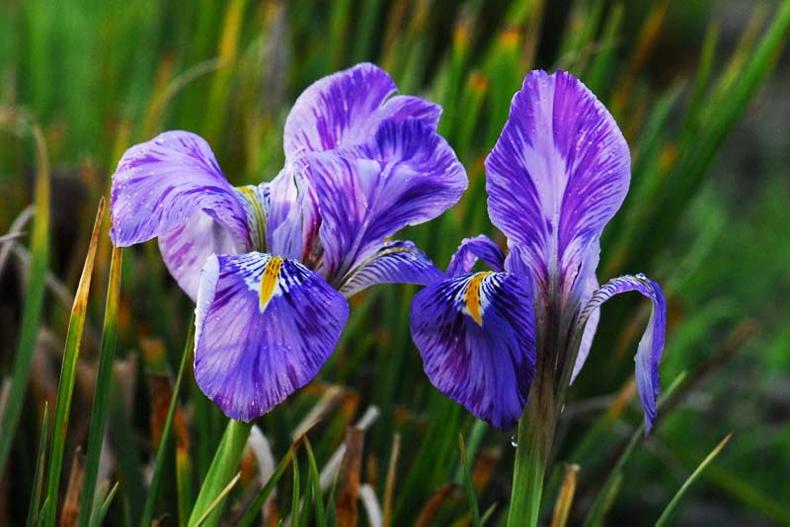The giants of the plant world. Indeed, the biggest living things on the planet are towering trees. When fully grown, these trees have a true presence, soaring to dizzying heights. Standing at the foot of such a specimen one has to lean back and crane the head to see the top, 30m or even 40m above, as high as a 10-storey building. Such trees may be in their third century, having been planted during the collection craze of the 19th century. More than anything else, this era of establishment of arboreta was given momentum by the discovery of these giants in temperate areas of the world, especially in western North America, including redwoods, Sitka spruce, western hemlock, Douglas fir and western red cedar.
The western red cedar, Thuja plicata, from western North America, makes a conical tree of bright green to over 20m, though often less. As it ages the side branches arch outwards, sometimes touching the ground. In turn, these develop so the mature tree (at about 100 years) has several majestic, curving trunks. Its foliage is scented with resin and can be detected some distance away on a warm day.
The grand fir, Abies grandis, also from western North America, has soft needles on beautifully arranged, sweeping branches. It can grow well over 20m. As it ages, the lower branches are lost and the mighty trunk is revealed, with a more rounded branching head.
The Douglas fir, Pseudotsuga menziesii, is not grown much for decorative purposes but in the right location it is a most handsome tree, with a fine trunk and branches. It is fast-growing and eventually reaches over 20m.
The western hemlock, Tsuga heterophylla, has soft, fine needles, a straight, smooth trunk and sweeping branches. It’s a fine, decorative tree and can be planted as a single specimen or in a group.
Fully grown specimens of the Monterey cypress, Cupressus macrocarpa, are found all around the country, some truly massive.
There are lots of foreign pines, notably the Monterey pine, Pinus radiata, a fast-growing tree from Monterey, California, with long, bright-green needles and exceptional resistance to wind exposure. The redwoods are the biggest of these giants, capable of 40m or so, though often less.
The giant redwood, Sequoiadendron giganteum, is the most commonly seen of the these. A massive pillar of dark green with short branches and a huge trunk that can reach more than 2m in diameter at the base. It is very fast-growing, as is its close relative the Coast redwood, Sequoia sempervirens, which has more sweeping, wider branches from a similarly massive trunk.
But all the giants are not North American and there are many other fine coniferous trees from other parts of the world that are worthy of consideration for planting in gardens, or near gardens, where there is space. Like the North American trees, some of these were planted in a rush of popularity and mature specimens can be seen on older properties around the country.
The monkey puzzle, Araucaria araucana, from Chile, dates back to the same period of introduction and caused great interest in its day. It is still a very popular tree, though often planted in gardens that will eventually be too small to accommodate it. The great Atlantic cedar has been popular as a big specimen since ancient times. The deodar cedar, Cedrus deodara, comes from northern India and makes a very handsome tree, conical with drooping branches, in its early years and then losing its lower branches to form a majestic, flat-topped tree on a fine trunk. The European silver fir, Abies alba, is often seen growing on large estates to well over 20m. Nordmann or Caucasian fir makes a handsome tree of large size, now ironically popular as a Christmas tree.
In choosing big conifers, native trees should not be forgotten. Scots pine, Pinus sylvestris, is considered native and is widely grown, both as a decorative tree and as a timber tree. Conical when young, it soon loses its lower branches to form a rugged, orange-brown trunk and a flat top of dark blue-green foliage. Yew is another native that makes a fine tree and the ordinary yew with sweeping branches is a better tree than the upright form seen in church yards. But yew is poisonous and should only be planted where stock cannot wander. All the conifers mentioned need space, good deep, well-drained, but not overly dry soil and full sunshine to get their heads up in the air. Even a couple of these, planted now will be a legacy to the future.

Blue tits feeding in winter.
Although it might seem a waste of time and money to feed garden birds in a rural setting, the birds think differently. Of course, this might be because it is easier for birds to feed on a bird table or on bird feeders than to forage about looking for food. But a much greater range of birds use a bird table or feeders in a rural setting than in a town. Blackcaps and goldfinches or even woodpeckers have been spotted at them, and this helps to support bird populations – many of which have declined in recent decades. The blue tits, chaffinchs and siskins will be numerous. And sparrows, which had vanished from some parts of the country, are becoming a more common sight at bird tables. Supply some clean water too.
Trees, shrubs and roses
Planting can take place now or be delayed until spring if the weather is wet and the ground becomes sodden. Check that recently planted trees are properly staked – also stake any old shrubs that appear top heavy. Check on wall-trained climbers.
Fruit, vegetables and herbs
Old, useless vegetables should be chopped up and composted. Weeds should be removed or sprayed and the ground dug over roughly to allow it to weather during winter. Strawberry runners can be planted now.
Flowers
There is still time for planting spring bulbs and containers for spring display, and the garden shops still have plenty of stock. Perennial flowers can be planted or lifted and divided in the case of existing plants. Control weeds in flower beds.
Lawn
Mosskiller can be applied if moss was a problem last winter and spring. Sulphate of iron and other products can be used. A low-nitrogen compound fertiliser can maintain a little growth through winter and leave the lawn in good condition.
Greenhouse
Throw out any old plants that are past their best or half dead, because they are a source of pests and diseases. Tidy up all debris and reduce watering to just keep pots from going bone dry. Place rooted cuttings in a bright position.
The giants of the plant world. Indeed, the biggest living things on the planet are towering trees. When fully grown, these trees have a true presence, soaring to dizzying heights. Standing at the foot of such a specimen one has to lean back and crane the head to see the top, 30m or even 40m above, as high as a 10-storey building. Such trees may be in their third century, having been planted during the collection craze of the 19th century. More than anything else, this era of establishment of arboreta was given momentum by the discovery of these giants in temperate areas of the world, especially in western North America, including redwoods, Sitka spruce, western hemlock, Douglas fir and western red cedar.
The western red cedar, Thuja plicata, from western North America, makes a conical tree of bright green to over 20m, though often less. As it ages the side branches arch outwards, sometimes touching the ground. In turn, these develop so the mature tree (at about 100 years) has several majestic, curving trunks. Its foliage is scented with resin and can be detected some distance away on a warm day.
The grand fir, Abies grandis, also from western North America, has soft needles on beautifully arranged, sweeping branches. It can grow well over 20m. As it ages, the lower branches are lost and the mighty trunk is revealed, with a more rounded branching head.
The Douglas fir, Pseudotsuga menziesii, is not grown much for decorative purposes but in the right location it is a most handsome tree, with a fine trunk and branches. It is fast-growing and eventually reaches over 20m.
The western hemlock, Tsuga heterophylla, has soft, fine needles, a straight, smooth trunk and sweeping branches. It’s a fine, decorative tree and can be planted as a single specimen or in a group.
Fully grown specimens of the Monterey cypress, Cupressus macrocarpa, are found all around the country, some truly massive.
There are lots of foreign pines, notably the Monterey pine, Pinus radiata, a fast-growing tree from Monterey, California, with long, bright-green needles and exceptional resistance to wind exposure. The redwoods are the biggest of these giants, capable of 40m or so, though often less.
The giant redwood, Sequoiadendron giganteum, is the most commonly seen of the these. A massive pillar of dark green with short branches and a huge trunk that can reach more than 2m in diameter at the base. It is very fast-growing, as is its close relative the Coast redwood, Sequoia sempervirens, which has more sweeping, wider branches from a similarly massive trunk.
But all the giants are not North American and there are many other fine coniferous trees from other parts of the world that are worthy of consideration for planting in gardens, or near gardens, where there is space. Like the North American trees, some of these were planted in a rush of popularity and mature specimens can be seen on older properties around the country.
The monkey puzzle, Araucaria araucana, from Chile, dates back to the same period of introduction and caused great interest in its day. It is still a very popular tree, though often planted in gardens that will eventually be too small to accommodate it. The great Atlantic cedar has been popular as a big specimen since ancient times. The deodar cedar, Cedrus deodara, comes from northern India and makes a very handsome tree, conical with drooping branches, in its early years and then losing its lower branches to form a majestic, flat-topped tree on a fine trunk. The European silver fir, Abies alba, is often seen growing on large estates to well over 20m. Nordmann or Caucasian fir makes a handsome tree of large size, now ironically popular as a Christmas tree.
In choosing big conifers, native trees should not be forgotten. Scots pine, Pinus sylvestris, is considered native and is widely grown, both as a decorative tree and as a timber tree. Conical when young, it soon loses its lower branches to form a rugged, orange-brown trunk and a flat top of dark blue-green foliage. Yew is another native that makes a fine tree and the ordinary yew with sweeping branches is a better tree than the upright form seen in church yards. But yew is poisonous and should only be planted where stock cannot wander. All the conifers mentioned need space, good deep, well-drained, but not overly dry soil and full sunshine to get their heads up in the air. Even a couple of these, planted now will be a legacy to the future.

Blue tits feeding in winter.
Although it might seem a waste of time and money to feed garden birds in a rural setting, the birds think differently. Of course, this might be because it is easier for birds to feed on a bird table or on bird feeders than to forage about looking for food. But a much greater range of birds use a bird table or feeders in a rural setting than in a town. Blackcaps and goldfinches or even woodpeckers have been spotted at them, and this helps to support bird populations – many of which have declined in recent decades. The blue tits, chaffinchs and siskins will be numerous. And sparrows, which had vanished from some parts of the country, are becoming a more common sight at bird tables. Supply some clean water too.
Trees, shrubs and roses
Planting can take place now or be delayed until spring if the weather is wet and the ground becomes sodden. Check that recently planted trees are properly staked – also stake any old shrubs that appear top heavy. Check on wall-trained climbers.
Fruit, vegetables and herbs
Old, useless vegetables should be chopped up and composted. Weeds should be removed or sprayed and the ground dug over roughly to allow it to weather during winter. Strawberry runners can be planted now.
Flowers
There is still time for planting spring bulbs and containers for spring display, and the garden shops still have plenty of stock. Perennial flowers can be planted or lifted and divided in the case of existing plants. Control weeds in flower beds.
Lawn
Mosskiller can be applied if moss was a problem last winter and spring. Sulphate of iron and other products can be used. A low-nitrogen compound fertiliser can maintain a little growth through winter and leave the lawn in good condition.
Greenhouse
Throw out any old plants that are past their best or half dead, because they are a source of pests and diseases. Tidy up all debris and reduce watering to just keep pots from going bone dry. Place rooted cuttings in a bright position.










SHARING OPTIONS